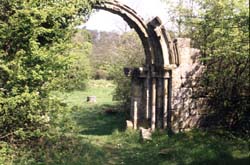 |
 |
 |
 |
 |
 |
 |
|
|
Robert of Newminster He was modest in demeanour, gentle in company,
merciful in judgement and notable for his holy life. Robert had been a monk of the Benedictine Abbey of Whitby, but joined the Fountains community soon after its arrival at Skelldale. In 1138 Robert was sent to lead Fountains’ daughter-house at Newminster, Northumberland, an abbey that was to found three daughter-houses of its own – Pipewell, Roche and Sawley. Robert died in 1159 and was buried in Newminster, probably in the chapter-house there; he was later translated to the church. A local cult developed.
Robert was celebrated for his sanctity and there were reports of posthumous miracles, by members of the community as well as outsiders. One particularly interesting example relates to a monk of Newminster who fell off his ladder when whitewashing the walls of the monks’ dormitory – his ladder had evidently been placed on the top of the stairway that connected the dormitory to the church. As the monk slipped and fell to the stone ground, he invoked the help of Robert, which evidently did the trick, for the monk escaped uninjured.(2) Little is now known of Robert, although an account of his life and miracles associated with him survives. This has been summarised by Watkin Williams, ‘Saint Robert of Newminster’, Downside Review 58 (1939), pp. 137-149.
|
